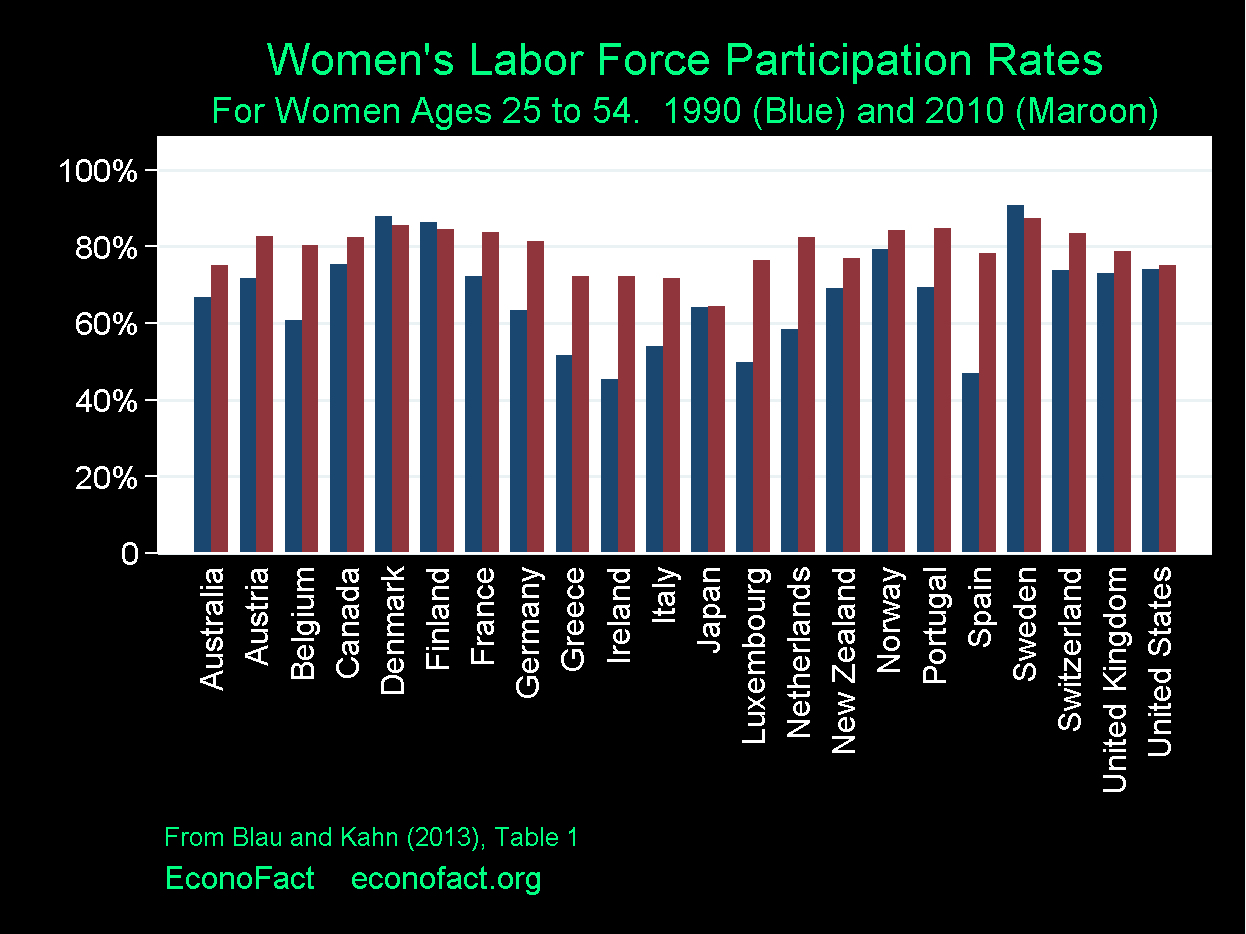Women and Paid Work: Is the U.S. Falling Behind?
Cornell University
The Issue:
Sustained economic growth requires, among other factors, growth in the labor force. The current low unemployment rate of 4.8 percent suggests that there is currently little slack in labor markets, and little scope for a growing labor force to foster growth. But the unemployment rate does not take into account working-age adults who are not currently trying to find work. A higher proportion of women than men are neither working nor looking for work, so finding ways to draw them into the labor force may expand labor supply and sustain economic growth. However, while the proportion of women in the U.S. labor force grew rapidly between the 1950s and the mid-1990s, this trend has slowed since. And the U.S. is now trailing behind other countries: Among 22 developed countries, the U.S. fell from sixth highest in women's labor force participation to 17th place between 1990 and 2010. Over this period, family-friendly labor policies such as parental leave, part-time work protection, and child care services expanded more significantly in other countries than in the U.S. Can adopting stronger policies for supporting working women, as proponents from both sides of the aisle champion, help draw more U.S. women to paid work?
Many countries have enacted parental leave, part-time work, and child care policies that are more extensive and generous than in the U.S.
The Facts:
- Female labor force participation rates in many countries surpassed that of the U.S. in the period between 1990 and 2010. While the U.S. female labor force participation rate rose from 74 percent in 1990 to 75 percent in 2010, the average rate for other countries from the Organisation for Economic Co-operation and Development (OECD) increased from 67 to 80 percent in the same time period (see chart).
- Many countries have enacted parental leave, part-time work, and child care policies that are more extensive and generous than in the U.S. This gap has grown over time. For example, government-mandated parental leave weeks increased from zero to 12 between 1990 and 2010 in the United States, while the average for the non-U.S. OECD countries increased from 37 to 57 weeks. Parental leave weeks are typically unpaid in the United States, but paid in most other OECD countries. Similarly, approximately 30 percent of non-U.S. OECD countries provide the right to part time work for parents, and 75 percent mandate equal treatment for part time workers while the U.S. has no provisions for either.
- Family-friendly policies increase female labor force participation and reduce the gender gap in labor force participation rates. According to our study, the female labor force participation rate grew about 13 percentage points more slowly in the U.S. than in other OECD countries from 1990 to 2010. Almost a third of this difference (28 percent) can be explained by differences in policies adopted by other countries, such as spending on parental leave and child care, that make it easier to balance work and family obligations.
- While female labor force participation rates have risen in other countries relative to the U.S., they might have come at the expense of women’s career advancement. Extremely generous parental leave mandates and a high incidence of part time work in non-U.S. countries may reduce the likelihood that women will be able to enter high-level jobs. The increased opportunity to take longer leaves can encourage women to take longer time out of the labor force, while part-time protections may encourage them to take part-time jobs over full-time jobs. Moreover, the mandate to provide more generous leave policies and more extensive part-time options may discourage employers from hiring women in the first place, especially for high-level jobs -- if they consider them more likely to make use of these policies.
- Women in the U.S. who are in the labor force are more likely to be working full-time and to work in higher-level positions than women in other countries. U.S. women are far less likely to work part-time than women in other countries, perhaps because there is greater accommodation made for part-time work in other countries. In addition, the women who stay in the labor force in the United States were also virtually equally likely as men to be managers in 1998 and 2009; in contrast, men were considerably more likely than women to be managers in other countries. These comparisons were based on a broad definition of managerial occupations, and we acknowledge that men are more likely to be in the highest-paying managerial jobs such as top executives and CEOs. U.S. women were also more likely than women in the other countries to work as professionals, especially in traditionally male-dominated professions.
What this Means:
Raising the participation rate of women in the workforce is important for realizing higher economic growth rates. Women are more likely to work when there are family-friendly labor policies such as parental leave, part-time work, and more options for childcare. About 28 to 29 percent of the U.S.’s lagging female labor force participation rates relative to other OECD countries is explained by its weaker family-oriented labor policies. Women who remain working in the U.S. are more likely to work full time and reach higher-level positions than their counterparts in other advanced countries, perhaps because in those countries friendlier policies enable women to opt for part-time jobs even though these offer less opportunity for advancement. Having said that, the United States currently lags so far behind the other countries in the provision and generosity of its leave and part-time policies, some expansion is unlikely to have substantial negative effects on women’s labor market outcomes. Moreover, greater provision of childcare is unlikely to adversely affect women’s outcomes because it unambiguously facilitates and encourages labor force commitment.
Like what you’re reading? Subscribe to EconoFact Premium for exclusive additional content, and invitations to Q&A’s with leading economists.

